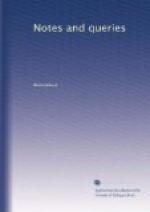s. d. Ecclesfield 6 7-1/2 Greno Firth 13 6 Southey Soke 10 7 Wadsley 4 6 L1 15 2-1/2
The above are the four byerlaws, or divisions of the parish, and the four churchwardens used separately to collect in their respective byerlaws; and then a fair copy of the whole was made out by the curate or schoolmaster. An ordinary collection in church, upon a brief, averaged 7_s_. 6_d_. at this period.
J. EASTWOOD.
Ecclesfield.
Borrowed Thoughts (Vol. i., p. 482.).—The number of “NOTES AND QUERIES” here alluded to has unluckily not reached me; but in Vol. ii., p. 30., I observe that your correspondent C., in correcting one error, has inadvertently committed another. Monsieur de la Palisse is the hero alluded to in the popular song which was written at the commencement of the eighteenth century by Bernard de la Monnoye, upon the old ballad, composed after the battle of Pavia, and commencing,—
“Helas! La Palice est mort,
Il est mort devant Pavie;
Helas! s’il n’estait pas mort,
Il serait encore en vie!”
W.J.
Havre.
North Sides of Churchyards (Vol. ii., p. 55.).—A portion of many churchyards is said to have been left unconsecrated, though not to be used as playground for the youth of the parish, but for the burial of excommunicated persons. This was {93} not, however, always on the north side of the church, as is evident from the following extract from the Register of Hart, Durham:—
“Dec. 17. 1596, Ellen Thompson, Fornicatrix (and then excommunicated), was buried of Þe people in Þe chaer at the entrance unto Þe Þeate or stile of Þe churchyard, on the east thereof.”
Nor is the north side of the church always the less favourite part for burial. I could name many instances where this is the only part used.
The churchyard now within two hundred yards of me contains about an acre of ground; the larger portion of which lies to the south of the church, but has been very little used for sepulture till of late years, though the churchyard is very ancient. Even now the poor have an objection to bury their friends there. I believe the prejudice is always in favour of the part next the town or village; that on the other side of the church being generally called “the backside.”
I find various notices of excommunicated persons being very strangely buried, and in extraordinary places, but I have not as yet met with any act or injunction on the subject. If any of your readers can supply such a document, it would be extremely interesting and useful.
W.H.K.
D.B.
Monastery, Arrangement of one (Vol. i., p. 452.),—A.P.H., who requests any information respecting the extent, arrangement, and uses of a monastic building, has doubtless consulted Fosbroke’s British Monachism.




